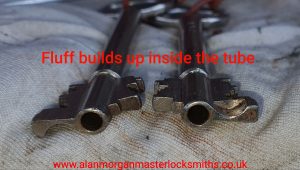Safe Identification And Problem Solving
ID pictures and description lower down page for safes and safe keys,
but if you are locked out of your safe right now, just send us pictures so that we can give an accurate estimate of costs and arrival time. Send pictures via WhatsApp or text SMS MMS to +447976272132 You can go to our contact us page or call 07976 272132 and we will send you our email address. Please add your postcode and reason for lockout as below.
Ideally take one photo showing the whole of the safe from the front. Then another picture showing the shape of the keyhole under the cover, or if a combination lock just a clear picture of the keypad or dial.
Please, please add a quick description of the actual problem please, we love safes and collect and admire pictures of safes, but without knowing what went wrong it is tricky to estimate the costs to fix it !
Common example problems:-
- Keys are lost or stolen
- Key stopped working, ( does it turn at all? How far please? )
- We don't know the combination but now someone has turned the dial
- The keypad is dead even after battery change or bleeps but won't open
- Burglars attacked the safe and now it doesn't open
- Not forgetting - "It was REALLY difficult to close it last night and now this morning it won't open" or the other classic, "A bit of the key broke off in the lock so we put superglue all over the long bit and tried to stick it together inside the lock!" (Please don't do either of these things)
Types of safe and lock styles listed below
Freestanding safes
As above, safes which stand on the floor. Can be to give security protection like the Chubb or fire protection like the Phoenix below. Data safes have more insulation but thinner steel. Any freestanding safe weighing less than 1 tonne should be bolted down to achieve maximum security and insurance cover.
A Data Safe or Fire Safe
Under Floor Safes
As shown above, Under Floor Safes or UFS are designed to be set into a concrete floor which helps to protect the safe. Unobtrusive and very secure but can be inconvenient to use.
Wall Safes
Designed to be bricked into a wall which then helps to protect the safe from attack and removal. Similar design to floor board safes which fit between joists of a wooden floor.
Antique safes
Many safes made prior to 1920 do not meet modern security requirements due to advances in metallurgy and manufacturing. Some can still be useful and some were beautifully made and still have value. A few of the locks are works of art.
If your safe has a brass handle and brass nameplate that's the first clue. the other major giveaway is seeing hinges similar to the pictures below. If the sides and top are obviously separate plates of metal rather than a seamless box with radiused edges then it's likely to be older and lower grade.

Brass handles, pressed or cast name plaque, patch on paint where plaque used to be, fixed riveted hinges with no adjustment, sharp corners at front with layers visible. This ticks all the boxes.

Thomas Skidmore safe with anti pick lock. Note the wood effect decoration which is just beautiful paintwork and the raised decorative beading. As well like before a brass knob and stylised keyhole and traditional hinges.
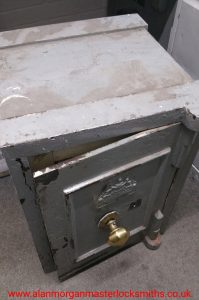
The safes above and below have a feature known as banding. The additional metal is there to add strength. Above is a John Port safe, it has been painted over but the decorative raised beading and bands can be seen. Brass handle and escutcheon again. Below is a Milner banded safe, later style knuckle / butt hinges, still no adjustment on these. The handles are pure brass just very discoloured, as is the raised Milner name plate.

Hopefully the above images have given an idea as to the style seen in safes made between 1850 and 1920. Before that it was often a large cast key which moved the boltwork and a small handle just to pull the door. Commonly known as Carrons chests after one of the main ironworks of the time. See below.
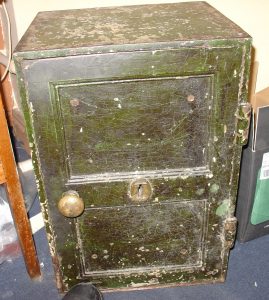
Large keyhole halfway up door, fixed handle. Sometimes the iron body plates will have panelled sections and even carry handles on both ends.
Single Bitted Safe Keys and Keyhole
Single bitted keyhole, similar to a traditional door lock
Double Bitted Safe Keys and Key Holes
Double bitted keyholes in safes.
Other types of safe key
Fichet Safe Key
Mauer Varos Safe Key
Mauer Varos safe keys. If these start catching or become difficult to open, get them changed as soon as possible.
La Gard 2200 Safe Key
Distinctive black plastic key bow for La Gard 2200 2270
La Gard 2200 series key tip. Be careful not to damage these as they are soft brass. Please keep the end clean as pocket fluff builds up inside the lock.
Detachable safe key types
These are detachable keys where the end separates so you have less to carry
Mauer style, similar to Kromer system
Above is a Rosengren key stem. Distinctive shape bow with knurled wheel that unscrews the key bit. This fits RKL10 locks which we can pick open. The Rosengren ABN have the same bow but an angled wedge joint at the tip.
Slip bit style. Chubb, SLS, SMP, Tann, Ratner and some Milner locks use a small flat bit which fits through a slot in the key stem.
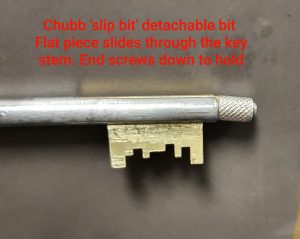
More pictures to follow
Common problems and solutions.
Electronic Digital Combination Locks
Electronic safe locks usually need decent power to unlock, normally they will still bleep and flash long after the batteries become too low to retract a solenoid or turn the motor. Always use the best quality alkaline batteries. If your lock stops opening the first thing to try is new batteries. If it is a cold morning sometimes when the room has warmed up the batteries might give enough to work. DO NOT lock the safe again, fit new batteries or leave it unlocked.
Many electronic locks have some contacts on the front or underneath to enable emergency power. See images below. On Kaba Mas Auditcon locks the metal studs are to connect a transponder fob not power.

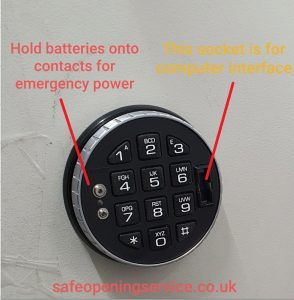


Key Locks
Pipe keys sometimes stop turning due to pocket lint and dust building up inside the hole. Every time you put the key in the lock, the pin pushes up into the pipe and compresses any fluff together. Over time so much gets jammed that the hole is no longer deep enough. A small drill or stiff wire can dislodge the fluff such that you can open your safe again.
